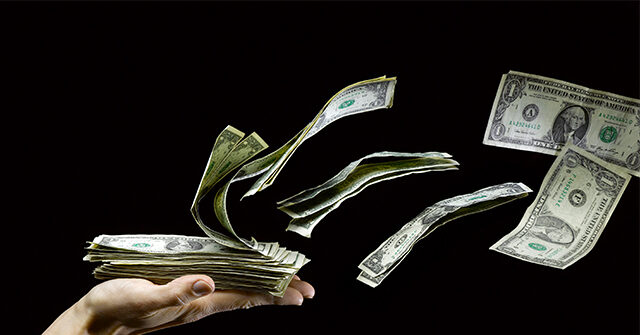You might have thought that we would get a respite on bad inflation news after the hotter-than-expected prints from the producer price index and the consumer price index. You would have been wrong.
The University of Michigan’s survey of consumers showed an improvement in the present situation assessment but a worsening in both the expectations for economic conditions and inflation expectations. The year-ahead expectations figure had fallen in each of the previous months, descending from 5.3 percent in May and June to 4.7 percent in August, the lowest reading since September of last year. In this month’s preliminary reading, however, it jumped back to 5.1 percent, eliminating a good part of the summertime progress.
The five-year forecast for inflation rose to 2.9 percent, undoing the break-through from the 2.9 percent to 3.1 percent range that had seen September’s longterm expectation fall to 2.7. That was the lowest reading since April 2021 and a source of great reassurance to the ‘peak inflation’ crowd.
We’re on record as skeptical of the theory that inflation expectations determine future inflation. It remains, however, a central tenet of mainstream monetary economics. Even more importantly, the Federal Reserve’s officials pay very close attention to inflation expectations. They’re likely to view this survey’s data, if it holds up through the end of the month figure, as a significant setback. The momentum on inflation expectations has turned against the Fed.
The latest Economist/YouGov survey also shows inflation expectations growing. Where the University of Michigan survey asks for an inflation projection, the Economist/YouGov survey asks a simpler question: Will the rate of inflation be higher, lower, or about the same six months from now? This moved rapidly in favor of higher inflation in just the first weeks of this month. The survey taken from October 1 through October 4 showed that 44 percent of American adults believed the rate of inflation would rise, 22 percent thought it would stay the same, and 15 percent thought it would fall. Nineteen percent were not sure. The survey taken the following week has 47 percent seeing inflation higher, 21 percent about the same, and 15 percent lower.
Of course, surveys can be noisy. But this is the continuation of a trend, suggesting a signal that inflation expectations really are moving higher. At the start of September, the poll showed that 42 percent thought inflation would be higher in six months. So we’ve been traveling on this trajectory in expectations as month-to-month inflation was rising from the July low. We suspect this is evidence that the experience of inflation dominates the expectation of inflation. People expect inflation to be higher in the future because it is currently higher than it was in the past.
There’s been an interesting change in the ideological gaps in expectations. At the start of September, the Economist/YouGov poll showed just 21 percent of liberals saw inflation going higher, as did 38 percent of moderates and 67 percent of conservatives. In the latest poll, 31 percent of liberals, 46 percent of moderates, and 63 percent of conservatives see inflation going higher. So liberals and moderates are much more worried about inflation, while conservatives are slightly less fearful. One way of thinking about this is that the Biden administration and the Federal Reserve, which have sought to convince the public that inflation will be contained, have lost credibility with the left and the center.
This week’s inflation news has certainly moved market expectations when it comes to Fed policy. The odds implied by the Fed Funds futures market of a 75-basis point hike at the November 1-2 meeting jumped from 81 percent a week ago to 97 percent on Friday. The odds of a 75-basis point hike at the December meeting are up to 75 percent from 23 percent a week ago. On Friday alone these climbed around 14 percentage points. The odds that the Fed Funds target will be at five percent or above following the May meeting next year now stand at 45 percent. A week ago, futures markets were saying there was just a five percent chance of being that high.
The monthly Bloomberg survey of economists puts the probability of a recession over the next 12 months at 60 percent, up from 50 percent in September and double what it was six months ago. Meanwhile, the Economist/YouGov survey has 56 percent of the public saying that we are already in a recession. Among those who say we are not in a recession, 48 percent say it is somewhat or very likely that we will be in one in the next 12 months, and just 22 percent say it is somewhat or very unlikely. Looked at another way, 77 percent of the public think we are in a recession or that it is likely we will be in one in the next 12 months.
Let’s end on a joyous note. As we noted at the top of this digest, the University of Michigan survey of consumer assessments of current conditions improved in September, moving up to its highest reading since May. This might be related to the fact that consumer spending at what the Commerce Department calls “food services & drinking places” rose 0.5 percent in September compared with August. Compared with the first nine months of last year, spending on eating out and drinking in bars is up 17.9 percent. Inflation is raging, rates are soaring, and the economy is hurtling toward recession—but at least we can still break bread and drink beer with friends and family.
Related posts:
Views: 0
 RSS Feed
RSS Feed

















 October 15th, 2022
October 15th, 2022  Awake Goy
Awake Goy 
 Posted in
Posted in  Tags:
Tags: 
















